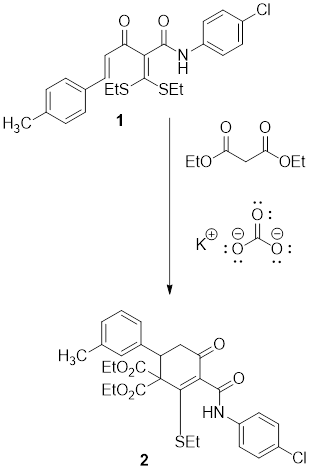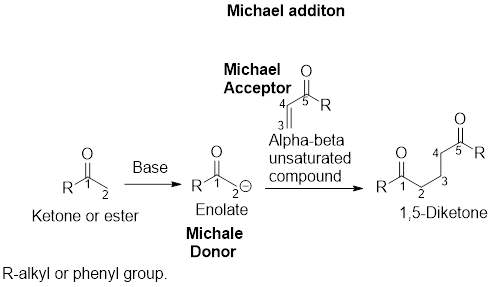
ORGANIC CHEMISTRY (LL) >CUSTOM PACKAGE<
3rd Edition
ISBN: 9781119781448
Author: Klein
Publisher: WILEY
expand_more
expand_more
format_list_bulleted
Question
Chapter 21, Problem 112IP
Interpretation Introduction
Interpretation: A plausible mechanism for the given reaction has to be proposed.
Concept Introduction:
The given reaction is:

This reaction is based on Michael addition reaction.
Michael addition:
It is the 1,4 addition of an enolate to an alpha beta unsaturated compound to form a difunctionalized compound. In this the enolate with the negative charge acts as a nucleophile while the alpha beta unsaturated compound with a double bond acts as an electrophile. In Michael addition, the nucleophilic species is called the Michael donor whereas the electrophilic species is called the Michael acceptor.
Example:

Expert Solution & Answer
Want to see the full answer?
Check out a sample textbook solution
Students have asked these similar questions
These are in the wrong boxes. Why does the one on the left have a lower molar mass than the one on the right?
SYNTHESIS REACTIONS. For the following reactions, synthesize the given products from the given reactants.
Multiple reactions/steps will be needed. For the one of the steps (ie reactions) in each synthesis, write out the
mechanism for that reaction and draw an energy diagram showing the correct number of hills and valleys for
that step's mechanism.
CI
b.
a.
Use acetylene (ethyne)
and any alkyl halide as
your starting materials
Br
C.
d.
"OH
OH
III.
OH
Calculate the pH and the pOH of each of the following solutions at 25 °C for which the substances ionize completely:
(a) 0.200 M HCl
Chapter 21 Solutions
ORGANIC CHEMISTRY (LL) >CUSTOM PACKAGE<
Ch. 21.1 - Prob. 1CCCh. 21.1 - Prob. 2CCCh. 21.1 - Prob. 3CCCh. 21.1 - Prob. 1LTSCh. 21.1 - Prob. 4PTSCh. 21.1 - APPLY the skill
As with aldehydes and ketones, the...Ch. 21.1 - Draw the enolate ion that is formed when each of...Ch. 21.1 - Prob. 7CCCh. 21.2 - Prob. 8CCCh. 21.2 - Prob. 9CC
Ch. 21.2 - Prob. 10CCCh. 21.2 - Prob. 11CCCh. 21.2 - Prob. 12CCCh. 21.2 - Prob. 13CCCh. 21.3 - Prob. 2LTSCh. 21.3 - Prob. 14PTSCh. 21.3 - Prob. 15PTSCh. 21.3 - Prob. 16ATSCh. 21.3 - Prob. 3LTSCh. 21.3 - Prob. 17PTSCh. 21.3 - Prob. 18ATSCh. 21.3 - Prob. 4LTSCh. 21.3 - Prob. 19PTSCh. 21.3 - Prob. 20ATSCh. 21.3 - Prob. 21CCCh. 21.3 - Prob. 22CCCh. 21.3 - Prob. 23CCCh. 21.4 - Prob. 24CCCh. 21.4 - Prob. 25CCCh. 21.4 - Prob. 26CCCh. 21.4 - Prob. 27CCCh. 21.4 - Prob. 28CCCh. 21.5 - Prob. 29CCCh. 21.5 - Prob. 30CCCh. 21.5 - Prob. 5LTSCh. 21.5 - Prob. 31PTSCh. 21.5 - Prob. 32ATSCh. 21.5 - Prob. 6LTSCh. 21.5 - Prob. 33PTSCh. 21.5 - Prob. 34ATSCh. 21.6 - Prob. 35CCCh. 21.6 - Prob. 36CCCh. 21.6 - Prob. 37CCCh. 21.6 - Prob. 7LTSCh. 21.6 - Prob. 38PTSCh. 21.6 - Prob. 39ATSCh. 21.6 - Prob. 40CCCh. 21.6 - Prob. 41CCCh. 21.7 - Prob. 8LTSCh. 21.7 - Prob. 42PTSCh. 21.7 - Prob. 43PTSCh. 21.7 - Prob. 9LTSCh. 21.7 - Prob. 45PTSCh. 21.7 - Prob. 46ATSCh. 21 - Prob. 47PPCh. 21 - Prob. 48PPCh. 21 - Prob. 49PPCh. 21 - Prob. 50PPCh. 21 - Prob. 51PPCh. 21 - Prob. 52PPCh. 21 - Prob. 53PPCh. 21 - Prob. 54PPCh. 21 - Prob. 55PPCh. 21 - Prob. 56PPCh. 21 - Prob. 57PPCh. 21 - Prob. 58PPCh. 21 - Prob. 59PPCh. 21 - Prob. 60PPCh. 21 - Prob. 61PPCh. 21 - Prob. 62PPCh. 21 - Prob. 63PPCh. 21 - Prob. 64PPCh. 21 - Prob. 65PPCh. 21 - Prob. 66PPCh. 21 - Prob. 67PPCh. 21 - Prob. 68PPCh. 21 - Prob. 69PPCh. 21 - Prob. 70PPCh. 21 - Prob. 71PPCh. 21 - Prob. 72PPCh. 21 - Prob. 73PPCh. 21 - Prob. 74PPCh. 21 - Prob. 75PPCh. 21 - Prob. 76PPCh. 21 - Prob. 77PPCh. 21 - Prob. 78PPCh. 21 - Prob. 79PPCh. 21 - Prob. 80PPCh. 21 - Prob. 81PPCh. 21 - Prob. 82PPCh. 21 - Prob. 83PPCh. 21 - Prob. 84PPCh. 21 - Prob. 85PPCh. 21 - Prob. 86PPCh. 21 - Prob. 87PPCh. 21 - Prob. 88PPCh. 21 - Prob. 89IPCh. 21 - Prob. 90IPCh. 21 - Prob. 91IPCh. 21 - Prob. 92IPCh. 21 - Prob. 93IPCh. 21 - Prob. 94IPCh. 21 - Prob. 95IPCh. 21 - Prob. 96IPCh. 21 - Prob. 97IPCh. 21 - Prob. 98IPCh. 21 - Prob. 99IPCh. 21 - Prob. 100IPCh. 21 - Prob. 101IPCh. 21 - Prob. 102IPCh. 21 - Prob. 103IPCh. 21 - Prob. 104IPCh. 21 - Prob. 105IPCh. 21 - Prob. 106IPCh. 21 - Prob. 107IPCh. 21 - Prob. 108IPCh. 21 - Prob. 109IPCh. 21 - Prob. 110IPCh. 21 - Prob. 111IPCh. 21 - Prob. 112IPCh. 21 - Prob. 113IPCh. 21 - Prob. 114IPCh. 21 - Prob. 115IPCh. 21 - Prob. 116CPCh. 21 - Prob. 117CPCh. 21 - Prob. 118CP
Knowledge Booster
Similar questions
- Calculate the pH and the pOH of each of the following solutions at 25 °C for which the substances ionize completely: (a) 0.000259 M HClO4arrow_forwardWhat is the pH of a 1.0 L buffer made with 0.300 mol of HF (Ka = 6.8 × 10⁻⁴) and 0.200 mol of NaF to which 0.160 mol of NaOH were added?arrow_forwardDetermine if the following salt is neutral, acidic or basic. If acidic or basic, write the appropriate equilibrium equation for the acid or base that exists when the salt is dissolved in aqueous solution. If neutral, simply write only NR. Be sure to include the proper phases for all species within the reaction. NaN₃arrow_forward
- A. Draw the structure of each of the following alcohols. Then draw and name the product you would expect to produce by the oxidation of each. a. 4-Methyl-2-heptanol b. 3,4-Dimethyl-1-pentanol c. 4-Ethyl-2-heptanol d. 5,7-Dichloro-3-heptanolarrow_forwardWhat is the pH of a 1.0 L buffer made with 0.300 mol of HF (Ka = 6.8 × 10⁻⁴) and 0.200 mol of NaF to which 0.160 mol of NaOH were added?arrow_forwardCan I please get help with this.arrow_forward
- Determine if the following salt is neutral, acidic or basic. If acidic or basic, write the appropriate equilibrium equation for the acid or base that exists when the salt is dissolved in aqueous solution. If neutral, simply write only NR. Be sure to include the proper phases for all species within the reaction. N₂H₅ClO₄arrow_forwardPlease help me with identifying these.arrow_forwardCan I please get help with this?arrow_forward
arrow_back_ios
SEE MORE QUESTIONS
arrow_forward_ios
Recommended textbooks for you
 ChemistryChemistryISBN:9781305957404Author:Steven S. Zumdahl, Susan A. Zumdahl, Donald J. DeCostePublisher:Cengage Learning
ChemistryChemistryISBN:9781305957404Author:Steven S. Zumdahl, Susan A. Zumdahl, Donald J. DeCostePublisher:Cengage Learning ChemistryChemistryISBN:9781259911156Author:Raymond Chang Dr., Jason Overby ProfessorPublisher:McGraw-Hill Education
ChemistryChemistryISBN:9781259911156Author:Raymond Chang Dr., Jason Overby ProfessorPublisher:McGraw-Hill Education Principles of Instrumental AnalysisChemistryISBN:9781305577213Author:Douglas A. Skoog, F. James Holler, Stanley R. CrouchPublisher:Cengage Learning
Principles of Instrumental AnalysisChemistryISBN:9781305577213Author:Douglas A. Skoog, F. James Holler, Stanley R. CrouchPublisher:Cengage Learning Organic ChemistryChemistryISBN:9780078021558Author:Janice Gorzynski Smith Dr.Publisher:McGraw-Hill Education
Organic ChemistryChemistryISBN:9780078021558Author:Janice Gorzynski Smith Dr.Publisher:McGraw-Hill Education Chemistry: Principles and ReactionsChemistryISBN:9781305079373Author:William L. Masterton, Cecile N. HurleyPublisher:Cengage Learning
Chemistry: Principles and ReactionsChemistryISBN:9781305079373Author:William L. Masterton, Cecile N. HurleyPublisher:Cengage Learning Elementary Principles of Chemical Processes, Bind...ChemistryISBN:9781118431221Author:Richard M. Felder, Ronald W. Rousseau, Lisa G. BullardPublisher:WILEY
Elementary Principles of Chemical Processes, Bind...ChemistryISBN:9781118431221Author:Richard M. Felder, Ronald W. Rousseau, Lisa G. BullardPublisher:WILEY

Chemistry
Chemistry
ISBN:9781305957404
Author:Steven S. Zumdahl, Susan A. Zumdahl, Donald J. DeCoste
Publisher:Cengage Learning

Chemistry
Chemistry
ISBN:9781259911156
Author:Raymond Chang Dr., Jason Overby Professor
Publisher:McGraw-Hill Education

Principles of Instrumental Analysis
Chemistry
ISBN:9781305577213
Author:Douglas A. Skoog, F. James Holler, Stanley R. Crouch
Publisher:Cengage Learning

Organic Chemistry
Chemistry
ISBN:9780078021558
Author:Janice Gorzynski Smith Dr.
Publisher:McGraw-Hill Education

Chemistry: Principles and Reactions
Chemistry
ISBN:9781305079373
Author:William L. Masterton, Cecile N. Hurley
Publisher:Cengage Learning

Elementary Principles of Chemical Processes, Bind...
Chemistry
ISBN:9781118431221
Author:Richard M. Felder, Ronald W. Rousseau, Lisa G. Bullard
Publisher:WILEY